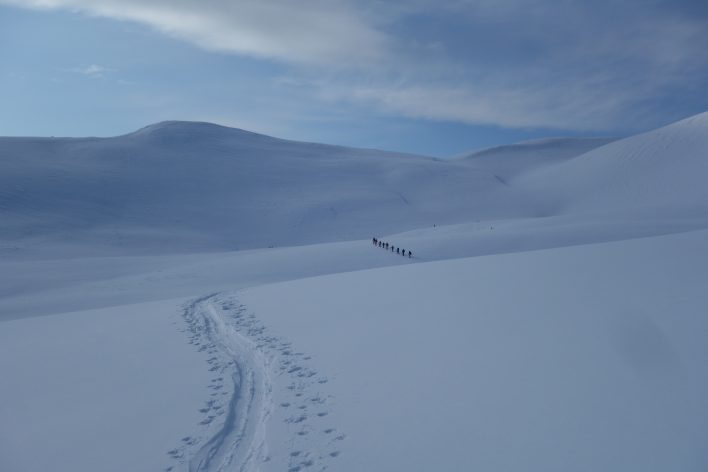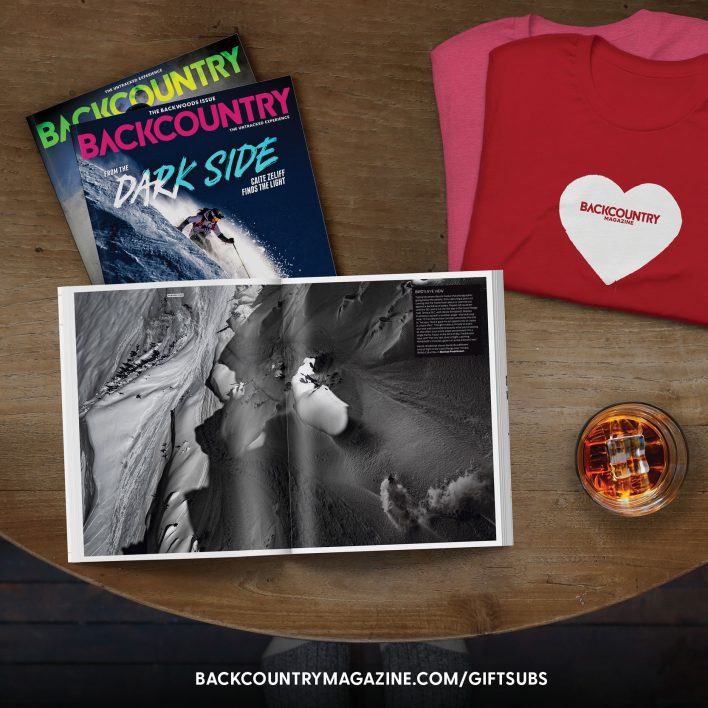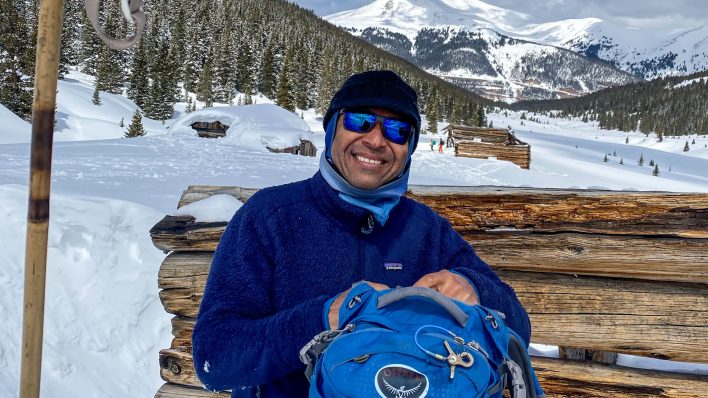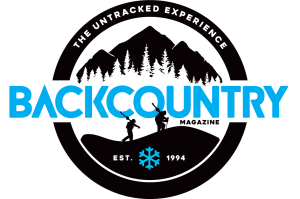In the fifth of six columns, Brett St. Clair shares the most important technique tips for backcountry skiing.

Know Your Gear
As a novice backcountry skier, it’s a good idea to familiarize yourself with your gear before you use it in the field. Put your skis on the rug in your living room and practice getting in and out of the bindings and transitioning them from walk to ski mode. Put your climbing skins on your skis, practice fastening the tail clips and adjust them if needed.
Your touring ski bindings have small metal plates called heel lifts or risers that make walking up steep pitches easier. Engaging those risers actually makes it more taxing to walk on flats or moderate uphills. Most experienced skiers and ski guides use their risers very little, opting instead to select a more moderate line uphill. So, save the risers until it gets steep.
Skinning

If you spot an existing skintrack headed uphill, it’s considered good form (and generally takes less effort) to follow it rather than putting another line in and tracking up the fresh snow other skiers want to hit on the downhill.
Setting a good skintrack is an art. The shortest distance between two points is a straight line, but climbing steeply straight uphill is much more tiring than working the terrain, taking a more moderate line by traversing your way up.
Pace yourself. If you are in a group, let the slowest person set the speed. If you are that slowest person, you’ll be doing your friends a favor if you don’t put yourself in the red trying to keep up with them and then having to stop repeatedly to recover. You’ll keep the group moving more efficiently by keeping your effort within what you can do and moving steadily.
It obviously takes more effort to break trail in deep snow. If you are among the slower members of your group, leave the trailbreaking to your stronger, more experienced friends. There’s no shame in that. Again, your responsibility is to keep the group moving as efficiently and steadily as possible.
If you are one of the stronger members of your group, it’s considered good form to offer to share in the trailbreaking. When you get out in front, keep the pace steady and don’t exhaust yourself. You’ll have set the group back if you blow up and need to take a break after your turn. Slow and steady wins the race.
By the same token, if you are leading the group, try to set a pace that works comfortably for everyone. Ski guides call this “client pace.” Guides are often way more experienced and fitter than their clients, but they know the way to get the most out of a day and give everyone a fun time is to keep the uphill pace comfortable.
One small observation: Novice backcountry skiers tend to noticeably lift their ski up during each forward step as if they were walking using snowshoes. It’s more efficient to unweight and slide your ski forward on the snow as if you were on Nordic skis and then weight it to get grip for the next step.
Transitions

When you reach the top of your intended ski run, the switch between uphill mode and downhill mode is called a transition. Transitioning quickly and efficiently takes practice and marks an experienced backcountry skier.
We’ve all seen video edits in which skimo racers effortlessness rip their climbing skins off the bottoms of their skis, switch the bindings into downhill mode without taking them off and hit the descent in 20 seconds. But most of us can’t do that.
What’s important is to become as smooth and efficient in doing this and the other tasks you’ll do in the gap between climbing up and heading down as possible. You’ll figure out what sequence works for you, but the key to being efficient is to routinize your sequence so you do the same things in the same order every time without doing anything twice.
For example, when you rip a skin, fold it and then rotate the heel piece of your tech binding on that ski so it’s ready to go when you put it on. That way you don’t go to put the ski on, engage the toe piece of your binding and then realize you left the heel in the uphill position and have to take your ski off to correct this (it happens).
One simple trick that can speed up your transition is to tuck your climbing skins inside your shell jacket rather than stowing them in your pack. Many jackets have interior pockets specifically for this, but you can do it with any jacket. Just make sure you are zipped up enough and your pack waist belt secures the bottom of your jacket so you don’t inadvertently lose a skin on the descent.
Downhill Technique

As mentioned previously, if you are new to alpine skiing or riding, it’s difficult to gain downhill technical proficiency solely in the backcountry. Even experienced skiers and riders find backcountry terrain challenging. Unlike a groomed resort run, the snow in the backcountry can be wildly inconsistent.
Deep powder, wind slab, ice or breakable crust all require adjusting your technique, as does ripping open bowls or navigating tight trees. The important thing is to approach difficult or unfamiliar snow conditions or terrain cautiously and feel your way into them. You do not want to get hurt or blow a knee three hours from a road.
The ability to negotiate challenging conditions is at the heart of the backcountry game. As you gain more experience, you’ll learn to adjust your technique and gain confidence. At times, all it takes is a run or two to get the feel for the snow you’re faced with.
If you ask an experienced backcountry skier what their technical ability level is, most will shrug and defer calling themselves an expert, advanced or intermediate skier, with the statement, “I can pretty much get down anything.”
Style points don’t count in the backcountry. The ability to get down anything does, and you’ll master that as you gain experience.
Brett St. Clair, with Craig Evanoff, is the author of Tips for Beginning Backcountry Skiers. Brett can be reached for questions or comments at brett@wskyline.com. If you’re an experienced backcountry skier but know someone who’s new to the sport and might find these tips useful, why not share this with them?











Related posts: